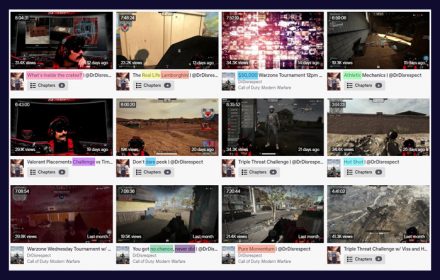In this guide you’ll find out how to make Twitch emotes. We’ll take a look at the things you need to think about, as well as Twitch’s rules and guidelines for emotes. This article covers:
- Generating Emote Ideas
- Twitch Emote Guidelines and Specifications
- Emote Design Tips
We’ll also discuss the benefits of designing yourself versus commissioning an emote artist.
Step One: Consider Your Community
The first step in emote design requires you to think about your community. Emotes help bond a community together, so it makes sense to first consider what they would want. You can even ask them. Letting your viewers take part in the ideas process can help make the emotes feel like a real community effort.
Let’s start brainstorming. Here are some questions to ask yourself:
- Are there any words or phrases often used in your chat?
- Do you have a name for your followers?
- Does your other branding have a theme?
- Are there specific games or genres which you often play?
The answers to these questions can often spark ideas, even if some don’t translate to an emote.
Many streamers tie their emotes into their branding. This can reinforce aspects of your style or personality. Emotes can also link to common themes or games found on your channel.
When narrowing down ideas think about the size of emotes. You need to pick themes which viewers can understand in a small and simple graphic. Your emotes are a reflection of you and your channel so ensure they are an accurate one.
Step Two: Think About Emote Situations
Once you have a theme it’s a good idea to consider the type of situations you want emotes for. There are many common emote uses, so you need to consider which come up most often in your channel. Here are some ideas:
- A welcome/hello emote – Celebrate new followers and subs or just say hi
- A LOL/facepalm emote – A staple in most communities
- A hype/excitement/love emote – Express your happiness
- A RIP/Death emote – Mourn your in-game demise
The above will cover some common situations you may want to use emotes in but they are far from the only ideas. Emote slots unlock as your community grows. So once you have the basics covered you can work on making some more niche or unique emotes.
Think of your emotes as a mini-ad for your channel. Every time a sub uses your emotes, it could entice another viewer into joining the community and subbing themselves.
With that in mind, think about moments in your stream where there is a lull in activity. Creating emotes to keep chat active is another strategy.
If you want to strike gold, make emotes unique and interesting. When they get used in other streams, it catches peoples eyes. This can get you new viewers or new subs just from interesting emotes.
Here are some other ideas for emote themes:
- Panic emote – Use when things go wrong
- Lurk emote – For those who don’t want to speak but want to say something
- BRB emote – Gives subs something to spam during AFK moments
- Rage emote – When things get too much
- Gasm/Booty emote – For when words aren’t appropriate
- Sad/crying emote – For those games which make you feel things
You can change your emotes at any time. So feel free to mix it up and see which ones get used the most. Community feedback is great for this so let them tell you what they want to express.
Step Three: Expand On Your Ideas
Once you have some ideas, the next stage is to take these and begin to sketch out rough outlines.
Even if you struggle with drawing. Seeing your ideas take some form can help you decide which ones work and which don’t.
Creators who aren’t artistically gifted may choose to commission an artist. Having rough sketches is still worthwhile either way, as they will help guide an artist. The more details you can get down on paper, the better the result will be.
One important thing to remember is to be unique. Don’t steal or copycat. Recoloring or even straight out copying emotes you find is a bad idea. Not only are you not being unique, but it could get you in trouble for breaking copyright.
You should also take care to use only photos or images that you own the rights to use or have created yourself. You are a professional, ensure your emotes reflect this. If you aren’t a designer, it might be best to hire one in these cases.
Step Four: Check The Guidelines
Twitch has guidelines for emotes, so you need to be sure to follow them. Check that your emotes comply at the planning stage. You don’t want to end up commissioning or drawing an emote which goes against the terms of service. They will get denied and you’ll waste a ton of time or money.
Some of the guidelines are obvious. Things like no hateful conduct, violence or offensive language and gestures. But you also need to stay away from politics, animations, and individual letters. Unless you are a partner and can justify their use in relation to your branding.
Twitch is also known for its strict guidelines on nudity and sexual content. While some streamers do have emotes of body parts or variants of the Kreygasm emote, these have to be clothed and tame in nature. Checking out other Twitch emotes is a good way to gauge what is or isn’t allowed.
Step Five: Design Your Emotes
Once you’ve found your themes you need to start designing your emotes and adding in the details. Here are some quick tips to help you get it right.
- Design at a large size and scale down to help avoid blur. Many artists suggest 800px x 800px as a base size.
- Exaggerant the tiny details, so they stand out when the emote is downscaled.
- Your best off to use software such as GIMP, Photoshop, or a custom emote maker. This will allow transparent backgrounds, and more design features unlike MS Paint.
- Try and link your emotes together. Remember you want them to get used often. So having a common theme works well when used together.
- If you’re struggling to design your own emotes you can also consider commissioning an artist. This will allow you to build a cohesive look for your brand, even if you struggle with art yourself.
Step Six: Check The Technical Specs
As well as conforming to content guidelines, emotes must also follow the technical rules set out by Twitch. Every emote submitted must be:
- A .png file
- Less than 25kb in size
- Submitted in 3 sizes, 28px x 28px, 56px x 56px and 112px x112px
- Have a transparent background
- Easily readable
- Clear and sharp
You will also need to choose a unique code that’s added after your emoticon prefix. Every emote has a prefix which relates to your channel name. That gets followed by a suffix which describes the emote.
Summary
The most important thing to remember is that emotes are a reflection of you, your channel, and your community. Make sure they are unique, easy to read and fun to use. Allow them to become a part of your channel and your branding.
You can also change emotes, so don’t be afraid to experiment with different themes and ideas. Just make sure not to make too many quick and drastic changes, or you risk confusing viewers.
Try and use your emotes to build on your branding and help your community express themselves.
Most of all make sure you love the result, emotes should always be something you’re proud of.


